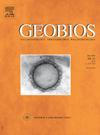来自 Berești 和 Mălușteni(罗马尼亚东部)上新世遗址的鱼类和有鳞类爬行动物--对古老但鲜为人知的材料的重新评估
IF 1.6
4区 地球科学
Q2 PALEONTOLOGY
引用次数: 0
摘要
本文对上新世早期Berești和Mălușteni(罗马尼亚东部)的硬骨鱼和有鳞爬行动物材料进行了修订,这些材料是在旧的收集中发现的,但从未详细描述过。鱼类组合包括一些鲤科物种(Rutilus robustus, Rutilus cf. R. frisii, Scardinius ponticus, Barbus sp., Tinca sp.), Silurus cf. S. soldatovi, pikes (Esox moldavicus和Esox sp.),以及不确定的鲑鱼,percid和sparid鱼的遗骸。鳞片类爬行动物的脊椎和颅骨材料分别属于拟蜥(Pseudopus pannonicus)和毒蛇(viperia Macrovipera sp)。这是迄今为止在罗马尼亚喀尔巴阡前陆所描述的上新世最具多样性的变温脊椎动物组合。所得结果有助于更好地理解中欧东部大陆脊椎动物区系的演化。本文章由计算机程序翻译,如有差异,请以英文原文为准。
Fishes and squamate reptiles from the Pliocene sites of Berești and Mălușteni (eastern Romania) – A reassessment of old but poorly known material
This paper performs a revision of teleost fish and squamate reptile material from the Early Pliocene sites of Berești and Mălușteni (eastern Romania), found in old collections, but never described in detail. The fish assemblage includes a few cyprinid species (Rutilus robustus, Rutilus cf. R. frisii, Scardinius ponticus, Barbus sp., Tinca sp.), Silurus cf. S. soldatovi, pikes (Esox moldavicus and Esox sp.), as well as indeterminate remains of salmonid, percid and sparid fishes. Squamate reptiles are represented by isolated vertebral and cranial material assigned to the anguid lizard Pseudopus pannonicus, as well as by isolated snake vertebrae belonging to the viperid Macrovipera sp. This is the most taxonomically diverse Pliocene ectothermic vertebrate assemblage described so far from the Romanian Carpathian Foreland. The obtained results contribute to a better understanding of continental vertebrate fauna evolution in the eastern part of central Europe.
求助全文
通过发布文献求助,成功后即可免费获取论文全文。
去求助
来源期刊

Geobios
地学-古生物学
CiteScore
3.30
自引率
6.20%
发文量
28
审稿时长
6-12 weeks
期刊介绍:
Geobios publishes bimonthly in English original peer-reviewed articles of international interest in any area of paleontology, paleobiology, paleoecology, paleobiogeography, (bio)stratigraphy and biogeochemistry. All taxonomic groups are treated, including microfossils, invertebrates, plants, vertebrates and ichnofossils.
Geobios welcomes descriptive papers based on original material (e.g. large Systematic Paleontology works), as well as more analytically and/or methodologically oriented papers, provided they offer strong and significant biochronological/biostratigraphical, paleobiogeographical, paleobiological and/or phylogenetic new insights and perspectices. A high priority level is given to synchronic and/or diachronic studies based on multi- or inter-disciplinary approaches mixing various fields of Earth and Life Sciences. Works based on extant data are also considered, provided they offer significant insights into geological-time studies.
 求助内容:
求助内容: 应助结果提醒方式:
应助结果提醒方式:


